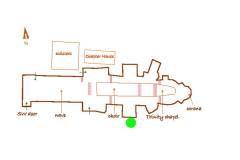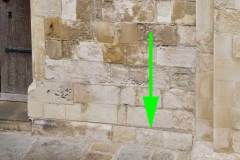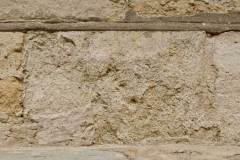Basics
Geology: Limestone
Rock unit: Bembridge Limestone Formation
Age: Oligocene
Provenance: Quarr, Isle of Wight
Where to see examples
Today the stone can be found as isolated fragments,
probably re-used, in the ruined infirmary walls and
in the exterior walls of the cathedral choir.
St Augustine’s Abbey and Canterbury Castle offer
better opportunities for viewing this stone.
On this page we show images from the external wall of the SE transept
Description
Quarr Stone is a freshwater limestone composed mainly of finely fragmented mollusc shells, representing an ancient shell-bank. The name ‘Quarr’ is derived from the Latin word ‘quadraria’ meaning quarry, there being a quarry on site before the abbey was built. On fresh exposure the rock displays a series of curved and broken shell rims nested together, which led to the local name ‘featherbed stone’ by the quarrymen. It is generally pale grey in appearance with a slight greenish-hue. Small grains of quartz sand exist between the shells and when the stone is seen to sparkle this is as a result of light reflected from crystal faces of secondary spar-calcite.
The quarries were intensively exploited in the eleventh and twelfth centuries and by the mid-twelfth century production was already on the wane. By the fourteenth century the beds had been worked out. The building stone was shipped out to many secular and ecclesiastical buildings on the south coast.
Quarr Stone is a hard-wearing stone and may have first been used for weathering features such as a plinth or a stringcourse in an early (Lanfranc’s time?) wall of the cathedral.



